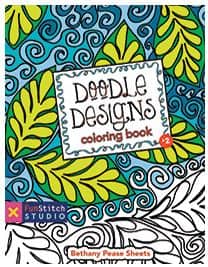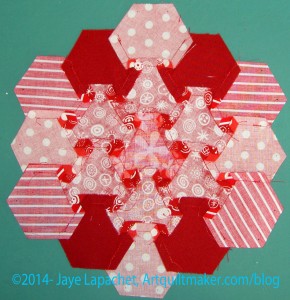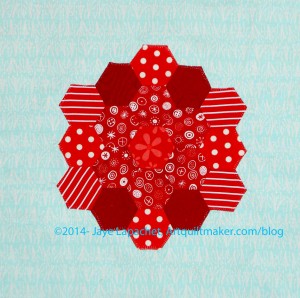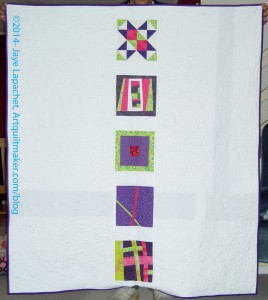Tips, Tricks & Traps
Need some tips or guidance on sewing laminated fabric (oilcloth)? Check out the Glorious Color tutorial. Thanks to Mark Lipinski for pointing it out.
Do you need help selecting a needle? I really liked the infographic from the Sewing Parts Online blog.
Jackie has some definitions of charms in a recent post, in case you were wondering.
Exhibitions, Articles and Quilt Shows
Cathy Izzo of the City Quilter in NYC reported, in her recent newsletter, about the GRAND CENTRAL CENTENNIAL QUILTS OPENING! It is their joint exhibition with American Patchwork & Quilting magazine and was celebrated in an opening event last Tuesday March 25, 2014. 20 of the 30 quilters represented in the show attended. This is a photo gallery from the party at the NY Transit Museum‘s Gallery at Grand Central Terminal.
The Wall Street Journal published a wonderful feature article on quilting and the Grand Central project last week.
To help everyone spread the word about the GCT exhibit, the City Quilter created an easy to remember web address that provides access to all the key information and links about the Grand Central effort: www.grandcentralquilts.com So you can spread the word, too.
If you are visiting NYC, you can find The City Quilter at 133 West 25th Street, New York, NY 10001 or you can contact them via phone at 212-807-0390.
Our Sunday edition of the San Francisco Chronicle had an article about Joe Cunningham (“Joe the quilter) who will be featured on Craft in America, the PBS series, next week.
Blogs, Quilts and Pretty Things
I have seen a few tie quilts lately that have really made me think that people are getting their creative groove on more and more. Perhaps the financial crisis is really over and creativity isn’t such a luxury anymore? Someone pointed me to the 24 Blocks blog where she shows a couple of tie quilts. I can’t decide whether I like the Dresden Plate or the 3D Tie quilt better.
Amy has post up about making Sara Lawson‘s Aragon Bag. The photos really show different views of the bag , which gave me a better sense of how it looks.
Remember last fall I made a Day in the Park backpack for Sara Lawson’s Purse Palooza? Marisa also made a Day in the Park Backpack. I am curious to see how she likes hers. Hers looks really different from mine. Different fabrics really changes the look.
Our friend, Sara over at Sew Sweetness has a lot of exciting news (she’s moving to WordPress!, for one) on her recent blog post. She may need some help sewing!
I love this quilt by Valerie, which she posted on her blog recently. It reminds me of the donation quilt on which I am working, but takes the idea a bit farther, evolves the idea I have been using a bit. It is also very nice in terms of color and arrangement.
Mom is working on Scrapitude. I posted some photos of a block to her blog since she is dealing with the learning curve of her new phone.
The other day I went to Britex with my mom. She hadn’t been there in awhile and was practically swooning at the thought. Britex is a pretty great place. The amount of fabric is startling. The number of button offerings is insane. They have embroidered and beaded appliques, multitudes of patterns and on and on. Of course, we had to go up to the floor with quiltmaking cottons where I saw one of the octopus prints from the Tula Pink Saltwater collection. This led me to finally watch a video that The Quilt Show posted about Tula Pink’s studio, which further led me to look around her website. I took a look at her blog and was kind of disappointed. I view other blogs through the lens of my own blog. I attempt to post good content that includes why I am doing what I am doing. As a designer, I know that marketing is part of the job and I expect to see posts on new fabric collections, machine endorsements, etc. I also would like to see more about their process. I saw a post Ms. Pink had written about her City Sampler blocks that people out in the world had made, which was wonderful, but in a few years worth of posts, nothing about her process. 🙁 I guess we can’t have everything. There must be something I am not understanding.
Patterns, Projects & Tutorials
Sara of Sew Sweetness also a new backpack pattern out: the Edelweiss Backpack. I haven’t made it, but the pictures show great structure. There are a number of different examples in all different types of fabric so you can get a god idea of what it would look like in any kind of fabric from large scale print to small flowers. The only thing I think is missing from some of Sara’s patterns are covers for the zippers. I don’t know how hard they are, but I think a zipper cover would give added professionalism to already professional looking bags.
Pam, of Hip to be a Square podcast and blog, has a hilarious pattern for a charm holder for your quilt guild nametag/lanyard. It is a great idea and her particular rendition is fun and lighthearted. It also provides inspiration for other versions of Pam’s flasher.
Tools & Supplies

I saw a book called Doodle Designs Coloring Book in a magazine ad the other day. I remember getting Doodle Art posters as a kid and spending lots of happy hours coloring them. I don’t know what happened to the posters, but the memory of the fun lingers on on in my mind. This book reminds me of that and I want one. The reality is that I probably wouldn’t have time to color it in, so I’ll probably just admire it from afar.
I have been trying to get a new insert for sewing table that will work with my backup machine. I hope to be able to sew on it more comfortably when my main machine is out of commission (cross your fingers that such a situation will not happen often!). What a drama! I thought I had a Horn cabinet, but after going back and forth with the Horn people several times, they finally decided that I do not have a Horn cabinet. My cabinet (who knows what brand?) is outfitted with a Horn lift.
Before I winkled out this nugget of information I visited the Horn dealer in the City. they are terrible. I really don’t like to bash small businesses, but I cannot find anything good about the shop or the service. They have so little interest in any kind of customer service that it makes me think the shop is a front for some kind of illegal operation. I don’t know that, but why have a sewing dealership and not want to sell? Frustrated and feeling like I didn’t need to go to a Horn dealer (the next closest one being about 30 miles away), I called a shop that is near me called Serge-A-Lot. I have driven past it several times on my way to and from picking up the Young Man, so I know it is close. I called on a whim and they were absolutely willing to help me. I was thrilled! I went in the next day with my insert and the ‘blank’ that fits into my sewing table when the lift is completely down. Sherri, the owner, measured and double checked and really helped me. She wasn’t sure if they could make an insert, but said she would contact her vendor and let me know. I sent a long a photo of my table, per her request and she got back to me right away saying she would know in a few days if they couldn’t make one and it might be several weeks to actually get it made. In either case, she promised to keep me in the loop. I haven’t heard back, so I assume I will be getting an insert at some point.
After we finished discussing the insert, she showed me a quilt that was quilted with the embroidery function of the BabyLock (Serge-A-Lot is a BabyLock dealer). She also showed me the vast amount of Floriani thread and stabilizers they carry. These items give me a reason to go and support her shop. I wish it were bigger and had more quilting stuff, but I am happy to have customer service. Perhaps I’ll be able to cross one thing off my ever growing To Do list. Stay tuned!
Quilt World News
Caryl Bryer Fallert and her husband (partner??), Ron, have sold their building in Paducah and will be moving to Port Townsend, Washington. More information is on the news tab of her site. The “home/shop/studio/gallery in Paducah to JoAnne and Jeff Louis, owners of Paper Pieces. http://paperpieces.com/ JoAnne, Jeff, and their staff will be moving their internet business into our building in early June, and they plan to re-open the shop as soon as they get settled.” Paper Pieces is the company from whom I buy my EPP papers. Paper Pieces will be selling Caryl’s fabric and publications after the transition.
Charlotte Scott has a new podcast published called the Slightly Mad Quilt Lady. I heard about this from Sandy who mentioned it in her episode #154. As of this writing, I haven’t listened to an episode, but it is on my list and I will report back.
And, yes, I have the next design series concept on my list. I’ll get to it soon.




































![Sewing machine[s] setup](https://www.artquiltmaker.com/blog/wp-content/uploads/2014/04/PICT4789sm-159x300.jpg)